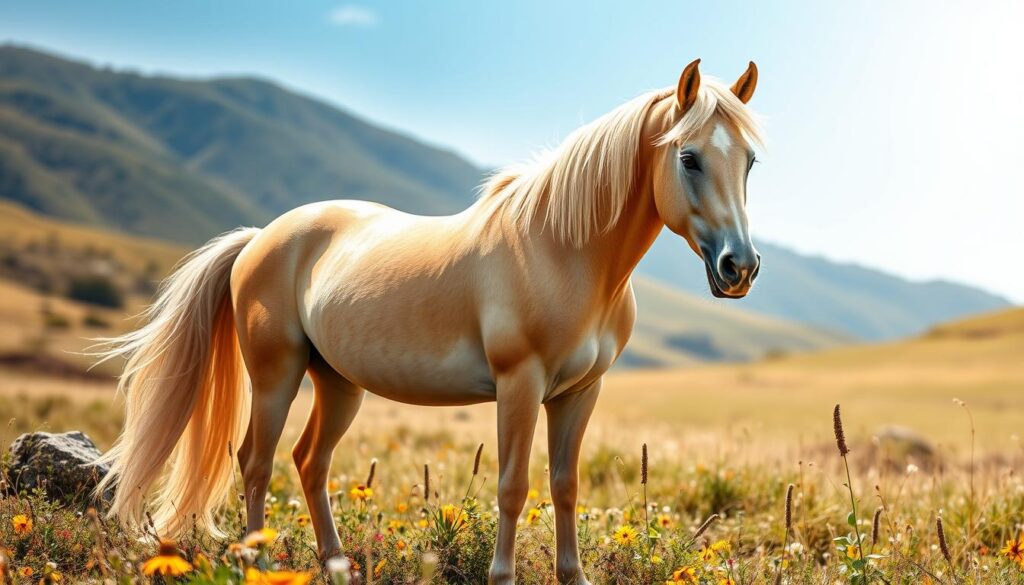Table of Contents
- Understanding the Unique Genetics Behind the Golden Coat
- The Rich History of Palomino Horses Through Ages
- Famous Palomino Horses in Pop Culture and Media
- Physical Characteristics of the Palomino Horse
- Essential Care Requirements for Palomino Coats
- Popular Breeds That Can Produce Palomino Coloring
- Training and Temperament of Palomino Horses
- Health Considerations Specific to Palominos
- Choosing the Perfect Palomino: Buyer’s Guide
- Show Ring Success: Competing with Palominos
- Maintaining Your Palomino Horse’s Value
- Common Myths and Misconceptions About Palominos
- The Global Palomino Horse Community
- Conclusion
- FAQ
Did you know only 1 in every 500 horses worldwide has a golden coat like a palomino? These stunning horses have amazed horse lovers for years. Their unique look and genetic traits make them special.
Palomino horses are more than their beautiful golden coats. They are also rich in history and culture. From Western ranches to Hollywood, they have always been admired.
We will explore seven amazing facts about palomino horses. These facts cover their genetics, cultural importance, and charm. Whether you love horses or just find them fascinating, you’ll learn something new about these golden beauties.
Key Takeaways
- Palomino horses represent a rare and stunning coat color
- Genetic factors determine the distinctive golden shade
- These horses appear in multiple breeds worldwide
- Coat color can range from light cremello to rich gold
- Palominos have significant cultural and historical significance
Understanding the Unique Genetics Behind the Golden Coat
Palomino horse genetics are a fascinating journey into the world of equine color inheritance. The stunning golden coat of palomino horses is due to a complex genetic process. This process involves specific color dilution mechanisms.
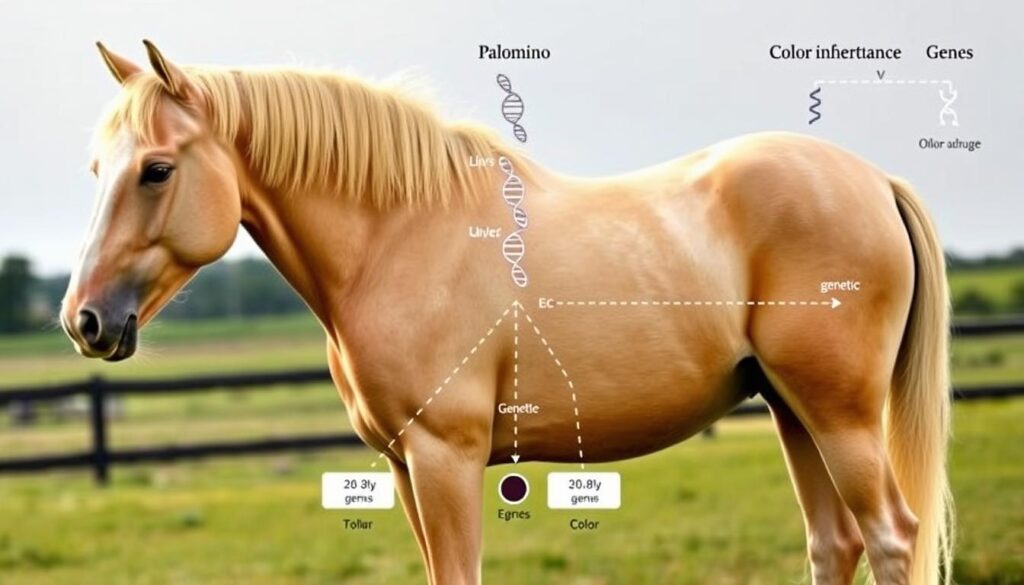
The Science of Cream Dilution Gene
The cream dilution gene is at the heart of palomino horse color. It’s a remarkable genetic variation that changes base coat colors. This gene lightens dark coat colors, creating the signature golden hue of palomino horses.
- Cream gene requires only one copy to produce palomino coloration
- Dilutes chestnut base coat to golden yellow
- Impacts coat color without changing horse’s underlying genetic structure
Color Inheritance Patterns
Palomino horse color inheritance follows intricate genetic rules. Breeding two palomino horses doesn’t always result in a palomino foal. Genetic combinations can lead to surprising results.
“Genetics is a game of chance, and horse color inheritance is no exception.” – Equine Genetics Expert
Genetic Testing and Breeding
Modern genetic testing has changed palomino horse breeding. Specialized DNA tests can predict coat colors with great accuracy. This helps breeders make informed decisions about potential offspring.
| Parent Colors | Probability of Palomino |
|---|---|
| Chestnut + Cream Gene | 50% |
| Palomino + Palomino | 25% |
Understanding palomino horse genetics requires patience and a deep appreciation for the intricate world of equine color inheritance. Each golden coat tells a unique genetic story.
The Rich History of Palomino Horses Through Ages
Palomino horses have amazed people for centuries. They have a rich story that spans continents. This journey is filled with beauty and usefulness.
In ancient times, people saw the golden coat as special. Spanish conquistadors loved palomino horses and brought them to the New World. Their golden color meant wealth and prestige.
“A palomino horse is like liquid sunlight with four legs” – Traditional Horse Breeder’s Saying
- Medieval European royalty saw palomino horses as symbols of nobility
- Native American tribes valued these horses for their unique look
- Military units often chose palomino horses for ceremonies
In the American West, palomino horses were key. Cowboys and settlers loved their looks and strength. The golden coat made them stand out in the wild, symbolizing freedom and adventure.
Today, breeding has made palomino horses even more special. Their history shows a deep bond between humans and these amazing horses.
Famous Palomino Horses in Pop Culture and Media
Palomino horses have won the hearts of people all over the world. They are stars in entertainment, sports, and military history. Their golden coats make them unforgettable.

The stories of famous palomino horses are full of legend. They inspire and amaze horse lovers everywhere. Their golden coats and unique personalities make them stand out in many fields.
Legendary Movie Star Horses
Some of the most loved palomino horses came from movies. Roy Rogers’ horse Trigger is the most famous. He starred in over 100 western films and became a Hollywood legend.
- Trigger: Starred in over 100 movies with Roy Rogers
- Mr. Ed: The talking palomino from the iconic 1960s television show
- Topper: Another famous movie palomino known for his exceptional training
Notable Show Ring Champions
Palomino horses have also shined in equestrian events. They’ve won many championships, showing their talent and skill.
Military and Ceremonial Palominos
Palomino horses have also served in the military and at ceremonies. Their beauty and strength made them great for parades and official events.
“A palomino horse is not just a color, but a statement of elegance and power.” – Equine Expert
Palomino horses have made their mark in movies, shows, and military events. They amaze everyone with their presence and abilities.
Physical Characteristics of the Palomino Horse
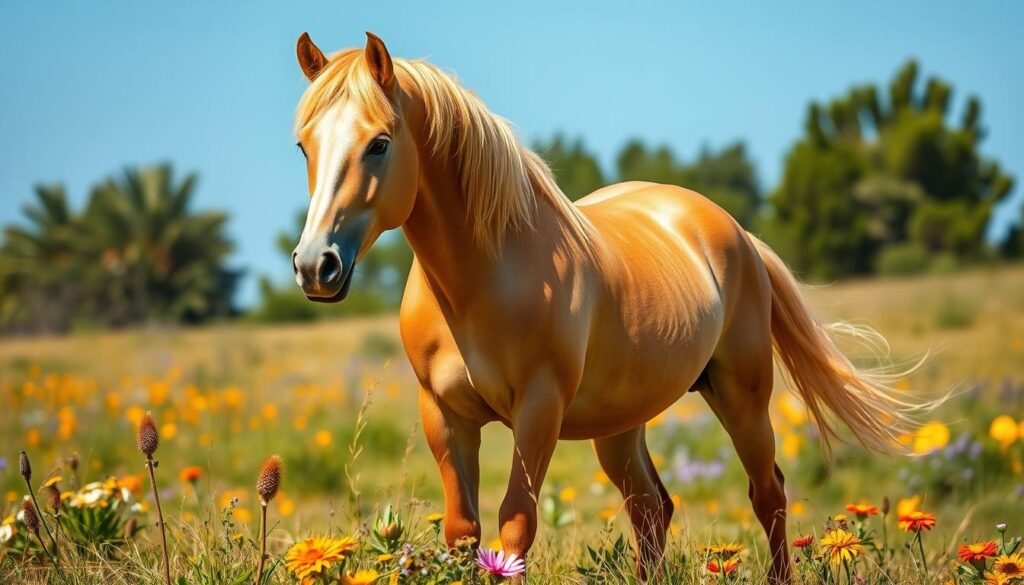
Palomino horses are known for their striking golden coats. They catch the eye of horse lovers everywhere. Their coats can range from light cremello to rich golden.
Their color is what makes them stand out. They have a shiny gold coat. This is matched by a white or light cream mane and tail. Together, they create a beautiful sight.
- Coat Color Range: Light gold to deep golden wheat
- Mane and Tail: Always white or very light cream
- Skin Tone: Usually pink or light-colored underneath the coat
- Height: Typically 14-17 hands tall
“The palomino is nature’s golden masterpiece, a living work of art that combines beauty and grace.” – Equine Color Genetics Expert
Palominos have different body types, but they are often athletic. They have strong muscles. They can also inherit traits from breeds like Quarter Horse, Morgan, or Arabian.
Palominos can have special markings like stars, snips, or socks. These add to their golden beauty. Genetic tests help breeders understand their color patterns.
Essential Care Requirements for Palomino Coats
Palomino horse care needs special attention to keep their golden coat looking great. These horses need a good grooming and nutrition plan. This helps keep their color bright and their health up.

Understanding what their coat needs is key to proper care. The golden color needs extra care to stay shiny and prevent fading.
Grooming Techniques for Golden Shine
- Use soft-bristled brushes to prevent coat damage
- Brush daily to distribute natural oils
- Select specialized shampoos for light-colored horses
- Avoid direct sunlight during intense grooming
Seasonal Coat Management
Seasons affect a palomino’s coat in different ways. In summer, they need sun protection. In winter, they need special care to keep their coat healthy.
- Apply UV-protective sprays in summer
- Use deep conditioning treatments during dry months
- Provide shelter from extreme weather conditions
Nutrition for Coat Health
“A healthy diet is the foundation of a beautiful palomino coat” – Equine Nutrition Experts
Nutrition is key for a palomino’s coat health. A balanced diet with the right nutrients keeps their coat shiny and vibrant.
- Include omega-3 fatty acids in diet
- Provide mineral supplements
- Ensure consistent hydration
- Choose high-quality protein sources
By following these care tips, owners can keep their palomino’s coat looking amazing and their health in top shape.
Popular Breeds That Can Produce Palomino Coloring
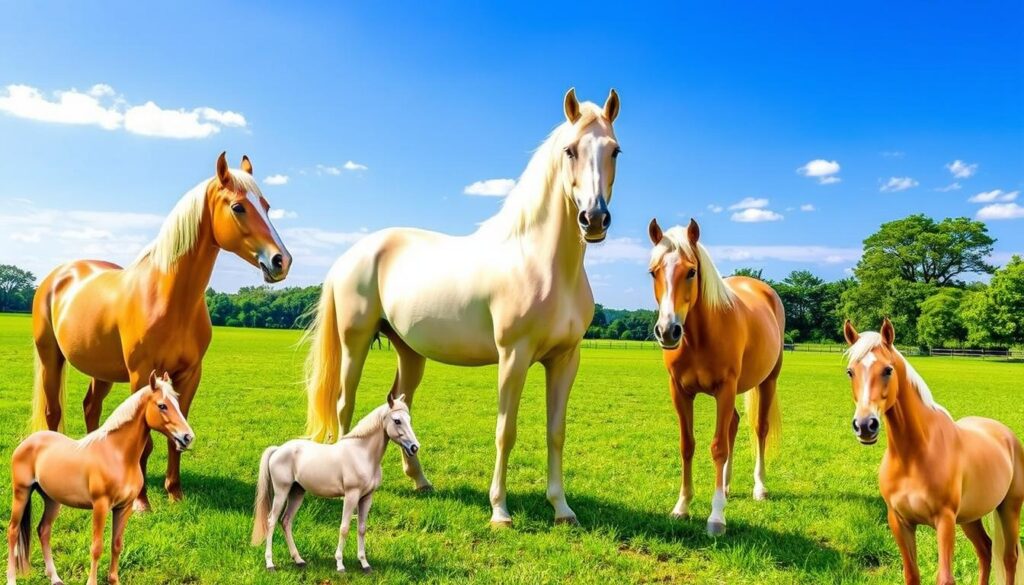
Palomino horse breeds show a beautiful color variation. This golden coat is not just for one breed. It appears in many popular horse types due to certain genetic combinations.
The cream dilution gene is key in creating the palomino coloring. Some breeds are more likely to have palomino horses. This makes studying genetics in horse breeding very interesting.
- Quarter Horses: Most common palomino horse breed
- Tennessee Walking Horses: Frequently produce golden coats
- Morgan Horses: Known for diverse color variations
- Thoroughbreds: Can occasionally produce palomino coloring
- Arabian Horses: Rare but possible palomino variations
“The beauty of palomino horse breeds lies in their genetic diversity and stunning golden appearance.” – Equine Color Genetics Expert
To breed palomino horses, you need to know about genetics. Not every horse in a breed will have palomino offspring. This makes the golden coat a rare genetic event.
| Horse Breed | Palomino Likelihood | Genetic Complexity |
|---|---|---|
| Quarter Horse | High | Moderate |
| Thoroughbred | Low | Complex |
| Morgan | Moderate | Simple |
| Arabian | Very Low | Highly Complex |
Professional breeders pick parent horses with certain genetic traits. They do this to increase the chance of getting palomino horses. Knowing about these genetic processes helps fans understand where the golden coat comes from.
Training and Temperament of Palomino Horses
Palomino horses are known for their beautiful golden coats and great minds. They are smart and easy to train. This makes them special in the world of horse training.
Mental Characteristics
Palomino horses have a sensitive and responsive nature. They are known for:
- High emotional intelligence
- Strong desire to please their riders
- Quick learning capabilities
- Adaptable nature across different disciplines
“A palomino’s spirit is as golden as its coat – bright, willing, and full of potential.” – Professional Horse Trainer
Training Approaches
Training palomino horses needs a careful approach. It’s important to respect their smart and sensitive nature. Good methods include:
- Positive reinforcement techniques
- Consistent and patient training methods
- Building trust through gentle communication
- Varied and engaging training sessions
Performance Capabilities
Palomino horses are great in many areas. They are agile and smart. This makes them excellent in:
- Western riding competitions
- Dressage
- Trail riding
- Show jumping
With the right training, palomino horses can be amazing friends and competitors. They show that beauty and talent can go together.
Health Considerations Specific to Palominos
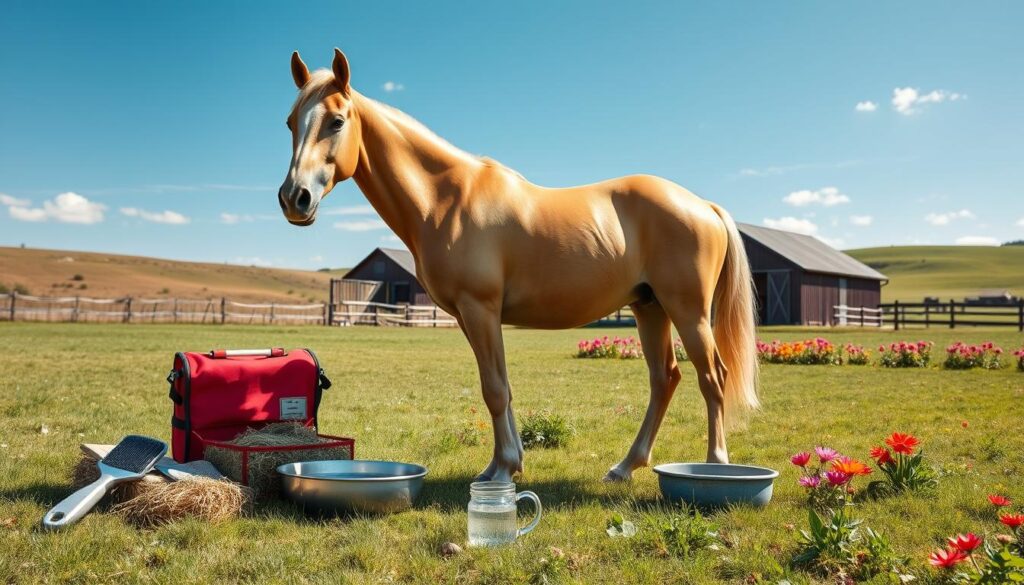
Palomino horse care needs special attention to unique health challenges. Light-colored horses like palominos face specific medical considerations. Owners must understand these to keep their horses well.
Skin sensitivities are a big deal for palominos. Their golden coats and lighter pigmentation make them more prone to sun-related issues. Veterinarians suggest using sunscreen and providing shade to prevent skin damage.
- Use high-SPF equine sunscreen on exposed areas
- Provide shade during peak sunlight hours
- Apply protective fly masks with UV protection
- Monitor skin for signs of sunburn or irritation
Genetic predispositions can impact palomino horse health. Coat color doesn’t directly cause medical conditions. But, some breed backgrounds might increase health risks.
“Understanding your palomino’s unique genetic makeup is key to preventive healthcare.” – Equine Veterinary Association
Nutrition is key to keeping a palomino healthy. Special diets that support coat quality and skin protection can help. This is especially important for their light color.
Regular vet visits, skin exams, and tailored care routines are essential. They help keep your palomino healthy and vibrant for life.
Choosing the Perfect Palomino: Buyer’s Guide
Buying a palomino horse needs careful thought and planning. You must consider many factors to find a quality horse that fits your needs.
Getting a palomino horse involves a lot of research and careful choice. It’s important to be methodical and well-informed when picking one.
Essential Assessment Criteria
When looking at a palomino horse, focus on key areas:
- Conformation and physical structure
- Age and health history
- Temperament and training level
- Performance potential
Documentation Requirements
Having the right documents is key when buying a palomino horse. You’ll need:
- Breed registration papers
- Veterinary health certificates
- Palomino horse registry verification
- Training and performance records
Price Considerations
The price of a palomino horse depends on several things. Here’s a detailed look at the costs:
| Horse Category | Price Range | Key Factors |
|---|---|---|
| Beginner/Recreational | $3,000 – $10,000 | Basic training, gentle temperament |
| Show/Performance | $10,000 – $50,000 | Advanced training, competitive lineage |
| Champion Bloodline | $50,000 – $150,000 | Exceptional genetics, proven performance |
“Selecting the right palomino horse is an investment in partnership and potential.” – Professional Horse Trainer
It’s wise to work with trusted palomino horse registries. They can help verify the horse’s background and confirm its documents. Prices and availability can vary by region, affecting your purchase.
Show Ring Success: Competing with Palominos
Palomino horses have made a big name for themselves in equestrian events. They show off their versatility and beautiful golden coats. These famous palomino horses always grab the judges’ attention in different show ring disciplines.
Competitive arenas give famous palomino horses many chances to show off their skills. Top show ring categories include:
- Western Pleasure
- Halter Classes
- Reining
- Hunter Under Saddle
- Equitation
“A great palomino doesn’t just compete—they command attention,” says professional horse trainer Sarah Martinez.
For palominos to succeed in the show ring, they need tough training and knowing their strengths. Experienced riders aim to show off the horse’s natural grace and athleticism.
| Competition Category | Palomino Strengths | Typical Scoring Criteria |
|---|---|---|
| Western Pleasure | Smooth Gaits | Movement Quality |
| Halter Classes | Coat Color | Conformation |
| Reining | Agility | Precision |
Getting ready for competitions is crucial for palomino horses. They need consistent training, the right food, and smart grooming. This can turn a good show into a winning one.
Maintaining Your Palomino Horse’s Value
Keeping your palomino horse’s value high needs careful planning and regular care. Owners know that it’s more than just basic upkeep. It’s about a detailed plan to keep the horse healthy and valuable.
Investment Protection Strategies
Keeping your palomino horse’s value up involves several key steps:
- Regular vet visits
- Continuous professional training
- Keeping detailed health records
- Thinking carefully about breeding
Documentation and Record Management
Keeping good records is key to your horse’s value. Buyers and breeders will look at detailed records. These show the horse’s health, family history, and past achievements.
| Record Type | Importance | Recommended Frequency |
|---|---|---|
| Medical Records | Tracks health history | Annually |
| Training Logs | Demonstrates skill progression | Every 6 months |
| Genetic Testing | Confirms breeding potential | Initial and periodic |
Professional Care Standards
High-quality care for your palomino horse means using experts. Vets, trainers, and nutritionists offer top advice. They help keep your horse in top shape and value.
A well-documented, professionally maintained palomino horse represents not just an animal, but a valuable genetic and performance asset.
By following these steps, you can keep and even grow your palomino horse’s value. This is through dedicated, professional care.
Common Myths and Misconceptions About Palominos
Palomino horses have long fascinated horse lovers. But, many myths surround these golden beauties. Learning about palomino horse facts can clear up these misconceptions and help us appreciate them more.
Many think palomino is a specific breed. But, this is not true. Palomino is actually a coat color found in many breeds. This color comes from a genetic mutation called the cream dilution gene.
- Myth: All palominos have identical temperaments
- Myth: Palomino horses are rare and extremely expensive
- Myth: Golden coats indicate superior performance
“Not every golden horse is a palomino, and not every palomino is the same” – Equine Color Genetics Expert
Some believe the golden coat of a palomino horse means they are better at riding. But, the golden color does not mean they are better at riding or performing.
| Myth | Reality |
|---|---|
| Palominos are always docile | Temperament varies by individual horse and breed |
| Golden coat means purebred | Coat color does not determine breed purity |
| All palominos look identical | Shade and intensity vary widely |
Knowing these facts about palomino horses helps us make better choices. It also lets us truly appreciate these amazing animals.
The Global Palomino Horse Community
Palomino horse fans worldwide love these beautiful golden horses. The palomino horse registry connects owners, breeders, and fans across the globe. It makes a lively and supportive community.
Finding other palomino lovers is now simple. Important groups help unite horse lovers:
- Palomino Horse Breeders of America (PHBA)
- International Palomino Horse Association
- Regional breed-specific clubs
The palomino horse registry is more than a record-keeping place. It connects horse lovers, sharing knowledge, resources, and celebrating the unique beauty of these golden horses.
“Our community is united by our love for the most magnificent golden horses on earth.” – Professional Palomino Breeder
Online platforms have changed how palomino horse owners connect. Social media groups, forums, and virtual events offer new ways to connect:
- Facebook breed-specific groups
- Online breeding and showing forums
- Virtual horse shows and competitions
The palomino horse community keeps growing. Whether you’re interested in owning one or already love them, there’s a place for you. This world is dynamic and welcoming.
Conclusion
The palomino horse is more than its beautiful golden coat. It’s a mix of genetic wonder, historical importance, and unmatched beauty. We’ve seen how these horses have evolved, from their genetics to their roles in culture and competitions.
For those interested in owning a horse, a palomino is more than a pretty face. It’s a deep commitment to a special breed. These horses can be found in shows, movies, and personal stables, showing their amazing adaptability and charm.
Palomino horses are special because of their shiny coats, rich history, and amazing abilities. They offer a unique experience for horse lovers. Their genetic perfection, historical value, and unique personalities make them a favorite among many.
Getting involved with palomino horses means joining a community that loves and protects these golden beauties. Your time with a palomino horse will be filled with connection, learning, and magic.
FAQ
What exactly is a palomino horse?
A palomino horse has a golden coat and white or cream-colored mane and tail. This is due to a genetic mutation called the cream dilution gene. They can be found in many breeds and have a color that ranges from light champagne to deep bronze.
How do palomino horses get their unique golden color?
The cream dilution gene creates the golden coat. This gene lightens the base coat color. A palomino usually comes from a chestnut horse with one cream gene, making the golden color.
Are palomino horses a specific breed?
No, palomino is a color variation, not a specific breed. This golden coat can appear in many breeds like Quarter Horses and Morgan Horses. Any horse with the right genetic combination can be a palomino.
How rare are palomino horses?
Palomino horses are not extremely rare but less common than other colors. The genetic requirements for their golden coat make them less frequent. Breeding two palominos doesn’t always result in palomino offspring, which makes them special.
Do palomino horses require special care?
Palomino horses need special care for their light-colored coat. They need extra sun protection and more frequent grooming. Regular bathing and coat treatments help keep their color bright.
Can palomino horses be registered?
Yes, there are registries like the Palomino Horse Breeders of America (PHBA) for palomino horses. These registries keep records and provide certification for horses that meet their standards. They help preserve and promote the palomino color.
What makes palomino horses so popular in media?
Palomino horses are visually striking and have been in many movies and TV shows. Famous palominos like Trigger have made them popular. Their golden coat makes them memorable and photogenic.
Are there different shades of palomino?
Yes, palomino horses can range from light cremello to deep gold coin color. The shade depends on the base coat color and genetic variations. Some palominos are champagne-colored, while others are deep golden.
Do palomino horses have any specific health concerns?
While coat color doesn’t directly affect health, light-colored palominos may be more sensitive to sun. They need extra protection from UV rays and careful skin management. Regular vet visits and sun protection are important.
How can I breed a palomino horse?
Breeding a palomino requires understanding genetics. Typically, breeding a chestnut horse with a cream gene to another with a cream gene increases the chance of a palomino. Genetic testing and expert advice can improve breeding success.
